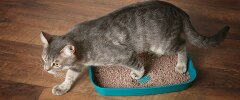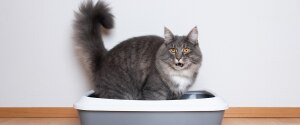
Whether you’re a seasoned cat owner, or have just welcomed a new cat into your home, you may have some questions about the do’s and don’ts of cat litter. We’ve got some cat litter box tips to keep your cat happy and to make cleaning their litter box a breeze.
DO:
1. Scoop the litter daily
To make sure that you’re meeting the needs of even the pickiest cat, you should scoop feces out of the litter box on a daily basis. This will keep the litter box clean and ensure that your cat isn’t using another location in your house as their personal litter box.
2. Clean the litter box regularly
How often you replace your litter depends on how many cats you have in your household along with the number of litter boxes you use. In general, you should change your litter every other week.
3. Refill box with fresh litter about 3 inches deep
Adding more litter to your cat’s litter box doesn’t mean that you’ll have to clean it less. In fact, most cats won’t even use a litter box that’s been overfilled with litter. When refilling your litter box, use fresh litter and make sure it’s about 3 inches deep so that there’s just enough for your cat to dig around in.
4. Have enough boxes for each cat to have their own, plus one
As a general rule, you should have one box per cat, plus one extra. For instance, if you have two cats, you should have three boxes in your home. By making sure that each cat has their own litter box to use, you can help ease elimination issues. Also, you should aim to have a box on every level of your home so that your cat can go to the bathroom comfortably.
DON’T:
1. Clean your litter box with ammonia
Clean your litter box with a mild soap. Make sure to never use any products with ammonia, as it can cause your cat to stop using their litter box, and in some cases, harsh cleaning products are toxic to cats.
2. Place the litter box in an undesirable area
Like all of us, cats love their privacy, so it’s best to set up your cat’s litter box in an area in your home that is quiet. Areas that are too noisy can make your cat nervous, causing your cat to stay away from the litter box.
It’s also important to make sure that the location is accessible to your cat. For instance, if you’re placing the litter box in the bathroom, make sure that the door remains open so that your cat can use the litter box freely.
3. Flush litter down the toilet or empty in the garden
Flushing cat litter can disrupt your plumbing and septic system and it can potentially be harmful to others. A parasite sometimes found in cat feces can cause toxoplasmosis, which can most commonly affect pregnant women and people with weakened immune systems. Properly disposing of your litter is beneficial to overall water quality. Used litter is also not recommended for garden use.
4. Switch litter types suddenly
Some cats are quite particular with their bathroom habits, so switching their litter can be a big change for them. When switching to a new cat litter, make sure to do so gradually. Start with 2/3 old litter and 1/3 new, increasing the new litter over time so your cat can get used to it.
Remember, cats appreciate a clean litter box and good litter box habits. Follow the above cat litter box tips and we’re sure that your cat will appreciate it!
Related articles



